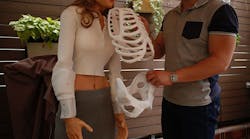It’s fair to say that Dr. William Dobbins followed an unusual path to the manufacturing industry.
Before taking the reins as president and CEO of Caster Concepts in 2003, Dobbins spent 25 years serving as a primary care physician in rural Albion, MI.
He spent that time, he says, dedicated to the treatment of generally blue collar families and workers from the local factories and businesses across the county.
In the process, Dobbins earned a healthy respect for the issues, the stresses, and especially the injuries those patients experienced on the job.
When he made the jump to manufacturing 12 years ago, he brought that experience with him. With every new product his company produces, with every new design, he says, those patients are right there with him along with all of their injuries and strains. In a sense, he is still treating them today.
Caster Concepts manufactures a broad range of caster wheels, rigs, and threads designed to help those patients. They bring ergonomics down to the very base of heavy-duty push/pull operations, allowing workers to transport more goods with less strain.
In other words, as a manufacturer, Dobbins is helping to eliminate the cause of workplace injuries that he once treated as an M.D.
In a recent conversation, Dr. Dobbins explained how he marries the seemingly disparate worlds of internal medicine and caster manufacturing and what that can teach other manufacturers about the importance of ergonomics.
Q: Moving from M.D. to CEO is a fascinating move. Could you explain how you were able to connect those two parts of your life?
Over the years, my partner and I developed significant relationships with different companies in town. If there were repetitive injuries of some sort in the work environment, we would go out and sort of study the work assignment, identify where and how the injury occurred, and identify certain kinds of stresses and strains that would lead to repetitive stress injury.
Fast forward about 10 years and, I’m working on the other side of that equation.
From that perspective, I know these are real problems in the industry. I know there are real problems that occur when people are doing various types of manual labor.
Frankly, casters are one of those things.”
Q: What exactly has that position enabled you to do?
“With my experience, I’ve been able to help address these problems that in a different way than other companies have.
That really means focusing on the issue. For us, it’s not just about solving one problem with one cart; it’s looking at the global issue. It’s seeing that a lot of people have this problem, too.
It’s not just Ford and Chrysler; it goes beyond that. It goes into the 50-person shop, the 10-person shop.
We have the responsibility and the opportunity to have an impact across markets and in different scopes and scales of businesses—businesses that may not even be totally aware that there are people that focus on this. People with just 25 carts, no ergonomics engineer, no safety engineer.
We can be their eyes and ears out there because we’re dealing with much larger companies.”
“I don’t think it’s unusual in manufacturing these days to be skeptical of certain amounts of injuries. There are malingerers out there and there are fakers. There’s no question about that.
But having seen it on the other side, I know there are real injuries.
Not everybody is a malingerer. Not everybody is just trying to get time off of work.
From a supplier standpoint, you have to believe there is a legitimate problem there. If you don’t believe there’s a legitimate problem, you’re not going to allocate the people, resources, time, and money to solve a problem you don’t believe is there.
The belief that there is a real problem is the first step to solving the problem.”
Q: Where do you go next?
“That’s something we’re really trying to understand.
We’re in the business of improving ergonomics on a hand-manipulated cart. Most of the focus up to this point has been on the caster. We’re coming close to a point where we have optimized those components as far as they can go.
When we get to that point, the question is where is the next area of improvement?
We still see incremental improvements that can be made in the caster. But if GM or Ford or Chrysler came to us and said in the next three years to go from 40 to 60-lb push/pulls on a 2,000-lb cart? That’s going to take more than just incremental improvements and nibbling around the edges.
It’s going to take something significant to happen.
It’s our belief that it will come not just from the caster, it will come from the cart and the interface of the caster and the cart. In the future, this might mean an opportunity to go in and design a complete ergonomic cart.”












